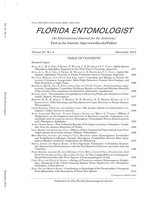The wide geographic range of Anastrepha ludens (Loew) (Diptera: Tephritidae) in Mexico and its ability to use various taxonomically unrelated host plant species suggests that this species has considerable evolutionary potential and represents a high risk pest. The genetic diversity and structure of A. ludens populations from 7 Mexican states (Chiapas, Yucatán, Morelos, Veracruz, San Luis Potosí, Tamaulipas and Durango) were investigated. Flies were collected as larvae from infested citrus fruits in each state, and sent as pupae to the Genetic Sexing Laboratory at the “Moscafrut ” facility in Metapa, Chiapas, where adults emerged and were used in isoenzymatic analysis. Genetic diversity was estimated based on expected and observed heterozygosity, mean number of alleles and polymorphism obtained from allelic and genotypic frequencies of 6 enzyme loci revealed in cellulose acetate. Expected heterozygosity (He) ranged from 0.199 to 0.330, and percentage of polymorphic loci (P) was between 50 and 67%. We found a high level of inbreeding (Fis = 0.393, Fit = 0.456) and moderate genetic differentiation among populations (Fst = 0.105). A negative correlation was found between elevation and He. We conclude that A. ludens populations are genetically diverse with moderate levels of differentiation. Genetic structure could not be attributed to the geographic distance among populations. Differentiation could be the result of natural selection associated with the colonization process. Genetic drift and pest management practices may have contributed to this differentiation to a lesser extent.
How to translate text using browser tools
1 December 2014
Genetic Structure of Populations of Anastrepha ludens (Diptera: Tephritidae) in Mexico
Mayra C. Molina-Nery,
Lorena Ruiz-Montoya,
C. Silvia Zepeda-Cisneros,
Pablo Liedo

Florida Entomologist
Vol. 97 • No. 4
December 2014
Vol. 97 • No. 4
December 2014
diversidad genética
flujo genético
gene flow
genetic diversity
genética de poblaciones
Mexican fruit fly
mosca Mexicana de la fruta




